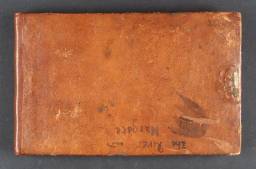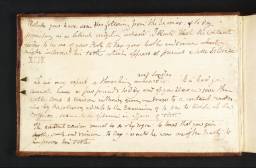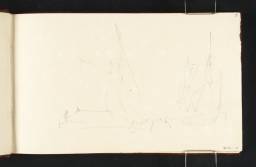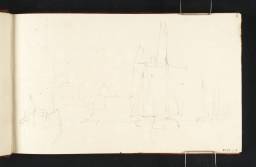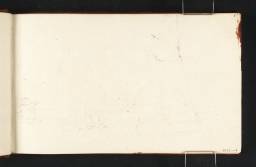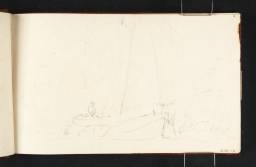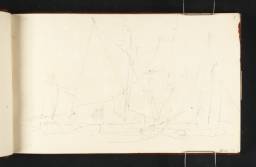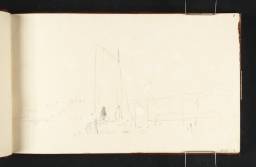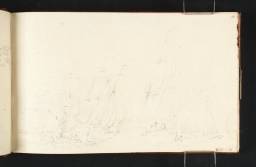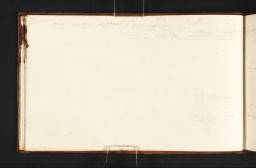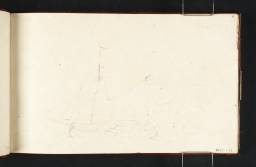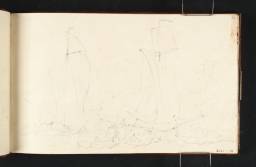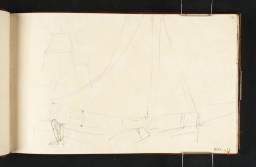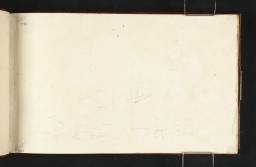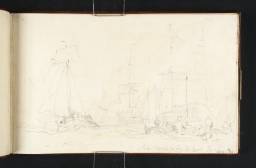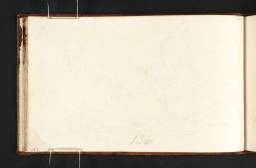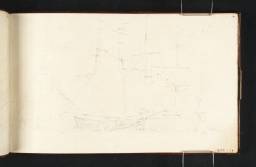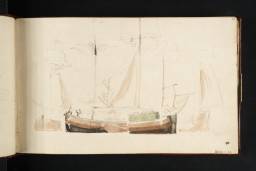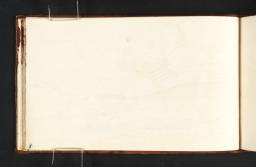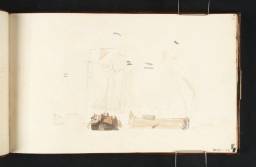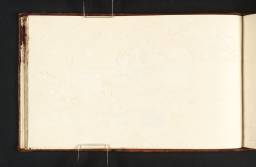Turner Bequest XCIX
Sketchbook, bound in calf, with one broken brass clasp
90 leaves of off-white wove paper made on a double-faced mould
Approximate page size 115 x 190 mm
Made by William Balston and the brothers Finch and Thomas Robert Hollingworth at Turkey Mill, Maidstone, Kent, and watermarked ‘J WHATMAN | 1804’
Inscribed by Turner in ink ‘The River and | Margate’ on front cover (D40596), inverted
Endorsed by the Executors of the Turner Bequest in ink ‘No.312 Contains 89 | leaves. Sketches in | Pencil & Colour’ and signed in ink by Henry Scott Trimmer and Charles Turner ‘H.S. Trimmer’ and ‘C. Turner’ and in pencil by John Prescott Knight and Charles Eastlake ‘J.P.K.’ and ‘C.L.E.’ inside back cover, inverted
Stamped in black ‘XCIX’ inside front cover
90 leaves of off-white wove paper made on a double-faced mould
Approximate page size 115 x 190 mm
Made by William Balston and the brothers Finch and Thomas Robert Hollingworth at Turkey Mill, Maidstone, Kent, and watermarked ‘J WHATMAN | 1804’
Inscribed by Turner in ink ‘The River and | Margate’ on front cover (D40596), inverted
Endorsed by the Executors of the Turner Bequest in ink ‘No.312 Contains 89 | leaves. Sketches in | Pencil & Colour’ and signed in ink by Henry Scott Trimmer and Charles Turner ‘H.S. Trimmer’ and ‘C. Turner’ and in pencil by John Prescott Knight and Charles Eastlake ‘J.P.K.’ and ‘C.L.E.’ inside back cover, inverted
Stamped in black ‘XCIX’ inside front cover
Accepted by the nation as part of the Turner Bequest 1856
Exhibition history
References
This sketchbook is mainly devoted to the Thames from Greenwich to the mouth of the Estuary. Turner was presumably sailing in his own boat, perhaps with friends as he was so often able to draw. Drawings, diagrams and costs for a kind of robust sailing dinghy might relate to this boat or plans to upgrade her; see folios 88 verso–89 verso and inside back cover (D06508–D06510; Turner Bequest XCIX 84a–85a, D40602). From the boat, Turner looks at naval and merchant shipping, barges and small boats and at the Essex shore to Southend and Foulness Island and the north Kent coast from the Isle of Sheppey to Margate and the North Foreland. Views of Rochester indicate a trip along the Medway as well. There are also sketches at Cobham, near Rochester, some of skies and others of figures.
Finberg’s date of 1806–8 is acceptable for most of the contents. However, the range should be extended back to the end of 1805 in case the book was used on Turner’s trip to see the Victory after her return from Trafalgar, and forwards to 1809 in the light of an inscription inside the front cover (D40597) relating to a letter in The Examiner in January that year. John Gage went so far as to date the whole book about 1809 on the evidence of this and his supposition that Finberg’s date of ‘1807’ arose from a misreading of a date written on the other cover.1 However, there are drawings for pictures exhibited perhaps in 1806 and certainly in 1808 and 1809. A view of Reculver, Kent, on folio 65 verso (D06464; Turner Bequest 61a) shows the cliff-top church and spires on the towers intact and their partial demolition in 1809 provides a terminus post quem for this subject at least.
Turner’s route along the Thames and Medway took him past important naval and defensive sites that were especially vital in time of war: the naval victualling yards at Deptford and bases at Chatham and Sheerness; the Great Lines above Chatham cleared to provide an open ‘field of fire’ to catch an enemy approaching the dockyard; the anchorage, mid-Thames, near the Nore sandbank; the gunpowder magazines at Purfleet at the edge of the Essex marshes and at the old artillery fort, Upnor Castle, on the Medway outside Rochester. Probably because these were sensitive sites with restricted access, as well as because Turner’s viewpoints were mainly from the water, the sketchbook offers no more than hints or distant glimpses of most of them. However, Turner did draw the Nore guardship, (folios 62, 63 verso: D06457, D06460; Turner Bequest XCIX 58, 59a), and the lightship (62 verso; D06458; Turner Bequest XCIX 58a); and the victualling of Navy ships especially caught his interest (for example folio 21: D06387; Turner Bequest XCIX 18).
Turner made good use of the sketchbook for the breezy sea-pieces that he exhibited at his Gallery, mainly in 1808, and also for unfinished paintings. Margate (Tate T03876; displayed at Petworth House) has as its background a view of the town and in the foreground an incident involving a ‘Hastings Herring Boat’ similar to one Turner drew on folio 68 verso (D06470; Turner Bequest XCIX 64a). The unfinished oil known as Margate, Setting Sun (Tate N02700) is more closely related, to folio 9 verso (D06372) which shows the same part of the town looking towards Fort Hill and Hooper’s Mill and also has a detail of the wooden structure, probably for drying nets and sails, seen on the left of the picture. Turner brought together two anchored hulks from folio 35 (D06411; Turner Bequest XCIX 31) and a sailing barge from folio 36 (D06413; Turner Bequest XCIX 32) in Confluence of the Thames and Medway (Tate T03874; displayed at Petworth House),2 perhaps an earlier work re-exhibited in 1808, on grounds of style.3 Finberg found some similarity in the grouping of naval and smaller vessels in folio 29 (D06399; Turner Bequest 25) to Purfleet and the Essex Shore (private collection),4 but there is also a sketch of Purfleet on folio 70 verso (D06474; Turner Bequest 66a) and the setting at the Nore and the background of low-lying shore could be based more generally on material in the book.
Discussing Purfleet and two other pictures, Sheerness as Seen from the Nore (Museum of Fine Arts, Houston)5 and Confluence of the Thames and Medway in his review of the 1808 exhibition at Turner’s Gallery, John Landseer imagined that those who had sailed down the Thames might think their backgrounds ‘little more than mere threads of distance’. But he added that they identified the locations, associated the pictures with a series and served an important compositional function in that ‘their horizontal lines impart a certain degree of steadiness’. This sketchbook provided Turner with his raw materials for those ‘threads of distance’, which observed from a boat gave little away. Only a few of his sketches are inscribed with their subjects and some of the others are hard to identify today.
At least two more pictures originated in this book. Among several related sketches of Gravesend, the busy harbour scene on folio 67 verso (D06468; Turner Bequest 63a) corresponds to the picture that Turner drew in outline, and named as ‘Gravesend’, in a letter of 12 December 1810 to Sir John Leicester, who must have asked what marines he had available.6 The picture is currently untraced.7 Drawings of interiors and figures like folio 77 (D06486; Turner Bequest XCIX 73), seemingly out of place in a book of mainly river and marine subjects, are for another exhibit of 1808, this time at the Royal Academy; The Unpaid Bill, or the Dentist Reproving his Son’s Prodigality (collection of the Schindler Family).8 Made for the connoisseur Richard Payne Knight, this picture was alleged by Benjamin West to have been painted in competition with David Wilkie’s interior genre scenes, and by Robert Hunt in his review in The Examiner to have been intended as a companion for a supposed Rembrandt in Payne Knight’s collection, The Holy Family at Night (then known as ‘The Cradle’) (Rijksmuseum, Amsterdam). More probably it referred to another of Payne Knight’s pictures, The Alchemist or Alchemist’s Laboratory then ascribed to one of Wilkie’s Old Master influences, David Teniers the Younger and more recently to Gerard Thomas. Turner’s evolving ideas for his composition can be traced through the drawings here. Others of the clerk and jury of a court leet (folios 51 verso, 52: D06437–8; Turner Bequest XCIX 47a–48) might reflect another idea for a narrative subject.
There are two other apparent anomalies in the book. One is a composition study on folio 75 (D06483; Turner Bequest XCIX 71) that seems to relate to Walton Bridges (National Gallery of Victoria, Melbourne), exhibited at Turner’s Gallery in 1807 and perhaps previously in 1806.9 If so this might be among the earliest drawings in the book. The other is a view of ‘Hastings Fish Market’ on folio 85 (D06501; Turner Bequest XCIX 81). There is no other evidence in the book of Turner working anywhere west of the City of London or along the Sussex coast. However, the drawings are more finished than most of the others, with similar hatching and shading, and need not have been made on the spot.
The book also bears on Turner’s academic and domestic affairs. His procrastination over beginning his lectures as Professor of Perspective at the Royal Academy, having been appointed to the post in December 1807, and the even longer delay of his friend John Soane, Professor of Architecture since 1806, had aroused comment. In December 1808 the Academy Council, aware that none of the Professors had lectured at all that year, asked for news of their progress and on 8 January 1809 an anonymous ‘Constant Reader’ wrote to The Examiner advising a thrashing for these ‘sons of indolence’. Notes inside the sketchbook’s cover (D40597) rehearse a reply, for the amusement of Turner’s colleagues over dinner or especially for Soane. Turner’s own architectural concerns are apparent in drawings for a narrow building with two arched windows, a door and a first-floor balcony, perhaps early ideas for a new studio or Gallery. Turner’s architectural interests may also have taken him to Cobham, a short detour by road from Rochester or Gravesend. Not only were there the ruins of a medieval College and the Elizabethan (and later) Cobham Hall but also the mausoleum of its owners, the Earls of Darnley, designed by James Wyatt for whom Turner had formerly worked. In the event, he drew only the ruins and the mansion.
Technical notes
How to cite
David Blayney Brown, ‘River and Margate sketchbook c.1805–9’, sketchbook, March 2009, in David Blayney Brown (ed.), J.M.W. Turner: Sketchbooks, Drawings and Watercolours, Tate Research Publication, December 2012, https://www

